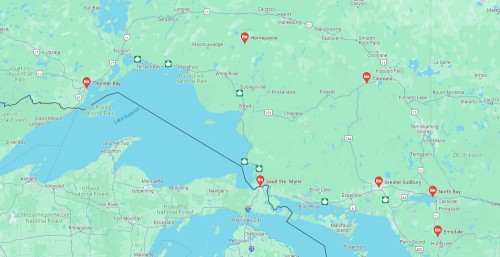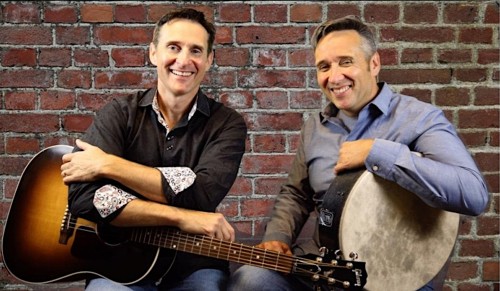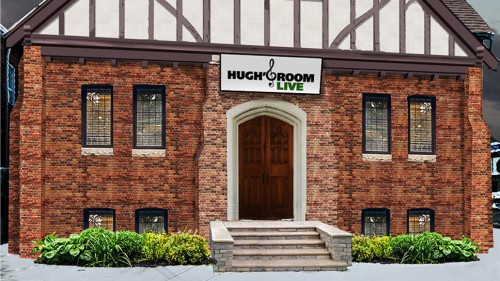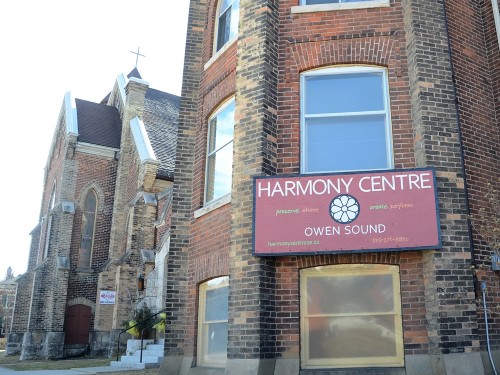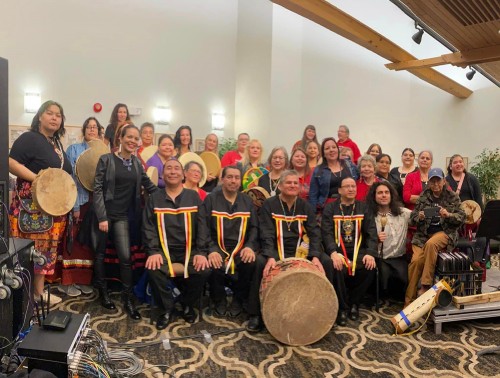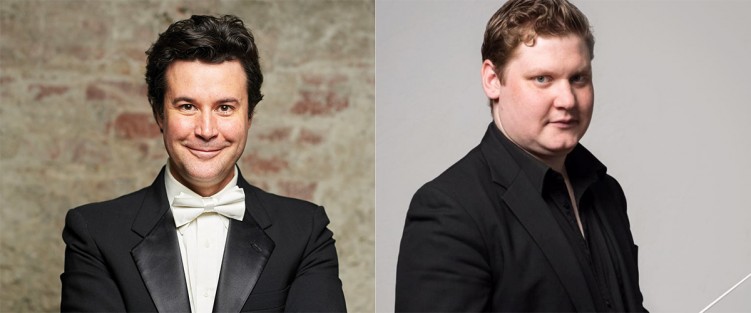 When it comes to defining the line between North and South in Ontario, it very much depends on who you ask and where you are.
When it comes to defining the line between North and South in Ontario, it very much depends on who you ask and where you are.
If you are using The WholeNote’s website to search for listings using the JUST ASK feature, you will find the province’s vast geography divided into zones, with all of “Northern Ontario” defined as “zone 10”, the southern border of which starts somewhere near Mattawa, and covers anything north of Algonquin Park and Highway 17 – with a bit of a dip south to also include Manitoulin Island. And it doesn’t seem to know where to classify Sundridge or Emdale, though I suspect if you asked people there, their compass would pull north rather than east, which is where LUDWIG (Listings Utility for WholeNote Information Gathering) – as it was affectionately dubbed back in the early 2000s – currently wants to put them.
In other words, like most government agencies and service sectors, The WholeNote lumps “the North” into one big zone that encompasses nearly half the province’s geography (if not necessarily the equivalent population!) and doesn’t yet have ways of accounting for and documenting the variety and richness of Northern musical life.
The (big) view from up here…
If I were keeping track of the state of the Ontario music and arts community purely from what I see on my social media feeds, or on the news, things would seem decidedly gloomy: this morning, for example, I woke up to another news story about how many arts festivals are on the brink of collapse, and every time an orchestra or arts company folds, or another venue or artist-friendly space closes, there is an outpouring of very understandable grief, and passionate conversation about the state of things and questions about what we “as a community” can do.
It’s why I still eagerly await a print copy of this magazine - because it’s physical, tangible proof of all the music that is still alive and surviving and even thriving. Similarly, using Orchestra Canada’s fantastic database as a starting place, I was able to go from there to find 81 orchestras in Ontario alone whose websites indicated they were still active. This includes professional “regional” orchestras, auditioned or non-auditioned community ensembles and – perhaps more important than all of these – youth orchestras training programs. Best of all, when I zoom the map in on “Northern Ontario” (as we have defined it), I discover that my “less populated” zone is already home to eight of these organizations. (As a relatively recent transplant to the zone, I know that “discover” is a very loaded word – like thinking you have discovered the full extent of food when you open your refrigerator door. I am constantly “discovering” things that are obvious to my neighbours - musically and otherwise.)
Five out of eight!
The Sudbury Symphony Orchestra used its season this year to bring in the finalists in their search for new leadership. They recently announced composer/conductor William Rowson as the new Artistic and Executive Director. Their April 20th program, Lights, Camera, Symphony will serve as his debut, which features the world premiere of Rowson’s Suite from the 2020 film Brotherhood, alongside some of John Williams most iconic film scores. Rowson also remains on as the music director for the Stratford Symphony Orchestra. It will be interesting to see whether this creates a model for collaboration and resource sharing across the north/south divide!
Rowson is not the only northern conductor pulling double-duty. Joshua Wood serves as Music Director for the symphonies in both North Bay and Timmins. His combined schedule for the 2023-24 season offers a small glimpse into what this kind of collaboration between orchestras can look like. The Timmins Symphony Orchestra has two concerts left in its main concert season – a collaboration with local favourites Dave and Don Carroll (The Sons of Maxwell) on April 6, and a Britain and Bohemia program featuring principal cellist Yu Pei with the Timmins Symphony Chorus on May 11. The North Bay Symphony is presenting a program of Brahms, Elgar and Haydn, featuring mezzo-soprano Rachel Wood on April 27, and closing their concert session with the Mendelssohn Octet on May 26. The final concert in Wood’s busy schedule brings players from both orchestra’s string sections together at St. Matthew’s Anglican Cathedral in Timmins for a joint chamber concert of works by Mendelssohn and Boccherini.
Heading west, you find the Sault Symphony Orchestra under the leadership of Artistic Director Stephen Mallinger. Their four-concert season wraps up on May 12, with The SSO On Broadway. Continue along Highway 17 and you find yourself at the western (and southern) end of Zone 10, where the Thunder Bay Symphony Orchestra has four concerts left in their masterworks, pops and family programming this year. Of particular note: returning by popular demand, on April 13, is The Spirit Horse Returns – a concert production that combines traditional teachings, original visual art, music and an all-new orchestral score by Kevin Lau, with Jodi Contin and Andrew Balfour. Suitable for all ages, it tells “the story of the Ojibwe Horses, traditional helpers and spirit guides for First Nations and Metis people. It’s a journey of hope and reconciliation as Indigenous and non-Indigenous people come together to rescue the last of these horses and give them new life. Suitable for all ages, this production is an entertaining opportunity to learn about Indigenous cultures, reconciliation, and how we all play a part in the future of the land and its inhabitants.”
Where does music live?
Of the 81 orchestras in Ontario that I found, only a very few have primary or sole occupancy of a “concert hall.” A handful more have shared tenancy at one of the regional or municipal “performing arts centres.” The further north you go, the wider the variety of spaces you see orchestras using: schools, community centres, historical buildings, union halls, cultural centres. An overwhelming number of orchestras use churches too, in some capacity. As the conversation continues to evolve about “who belongs” - in the orchestra, composing for the orchestra and in the audience – we need to recognize that how we choose the spaces we use is a big part of the picture.
Churches may be ideal rehearsal spaces, and acoustically good for orchestral music. But while the event you are hosting may be inclusive, and while your organization may have clearly outlined policies on Reconciliation, human rights, diversity and inclusion, it’s important to ask yourself whether the space actually lives up to those standards. At the very minimum it’s worth asking for the venue’s own written policies before you invite an audience into the space – so you spend your hard-earned venue money on spaces that are actively trying to make everyone feel safe. And no matter what the policies say, the question remains as to whether people with various lived experiences are ever going to feel safe enough to surrender to the magic of what is being created in a space where they are surrounded by religious iconography and text.
A whole other issue needs to be considered when you think about church and faith-based spaces as homes for orchestral music: the issue of aging and often dwindling congregations. Back down in Zone 1 (Toronto, this magazine’s birthplace), there are examples of solutions to this concern: in some cases, music can become the thing that revitalizes a church that is committed to inclusivity (like Metropolitan Community Church, or Trinity-St. Paul’s). Or when a congregation is eventually faced with closing up altogether, you end up, sometimes years later, with spaces like the new digs for Hugh’s Room, or as you head north, other examples like the Harmony Centre in Owen Sound.
Moving toward reconciliation
As we head back towards Zone 10, I have to admit that as a southern Ontario-raised person, Thunder Bay was a city that largely existed in my consciousness because of “bad news.” Now, of all of the orchestras in my zone, Thunder Bay Symphony Orchestra seems to be the one putting Reconciliation most at the forefront in a way that is based in action and focused on creating dialogue that helps us start chipping away at these complicated questions.
Their final concert of the season, May 3, is a free concert at Fort William Historical Park that has been an annual tradition since at least 2018. This year’s edition of the concert, titled Noondaagotoon, features the Thunder Mountain Singers, Juno-nominated cellist, composer Cris Derksen, and guitarist Lewis Chapman. TBSO’s website says: “Noondaagotoon means play it (so it makes a sound) in Ojibway. If you’ve been to a Noondaagotoon concert, you know this to be true. This annual collaboration between the TBSO and Indigenous performers has become one of the highlights of our season. It is an exciting opportunity to strengthen long-standing relationships – and establish new ones – while creating space for musical reconciliation with Fort William First Nation.” Seems like a good precedent for presenters and performers everywhere.
Back Home...
In my own community, the dedicated board at Grace United Church decided to disband and give up their home in their 100-year-old church, right downtown off the main intersection. The board was deliberate and careful as they wound down operations, in considering what they hoped the space would turn into, what kinds of other needs it could fill in the community, and what kind of legacy they wanted to leave in our township. They started by donating the grand piano to the public school.
They also worked alongside Amanda Drury, a lifelong community member, and gave her the time and support in her goal of purchasing the space as a home for Rise - a community holistic wellness centre. “The goal” Drury says, “is to provide services to help youth, adults and seniors connect, heal and grow in their own community.” She envisions a space where all feel valued and feel a sense of belonging and connection with others. “The arts, specifically music, have the power to do just that. One of the best ways to gather and connect people is through the arts, through feeling and expressing ourselves through different mediums.” She is already making the space available to musicians, artists and other community-based practitioners.
The sanctuary remains a beautiful acoustic space. It’s small, on the scale of church sanctuaries, and a whole symphony orchestra might be a bit of a squeeze. But the next time one of our northern organizations (or any other symphony) decides to send a chamber group on the road, our community is a bit more ready to give the music another home.
Sophia Perlman grew up bouncing around the jazz, opera, theatre and community arts scene in Toronto. She now eagerly awaits the arrival of her monthly WholeNote to Hornepayne, Ontario, where she uses it to armchair-travel and inform her Internet video consumption.


